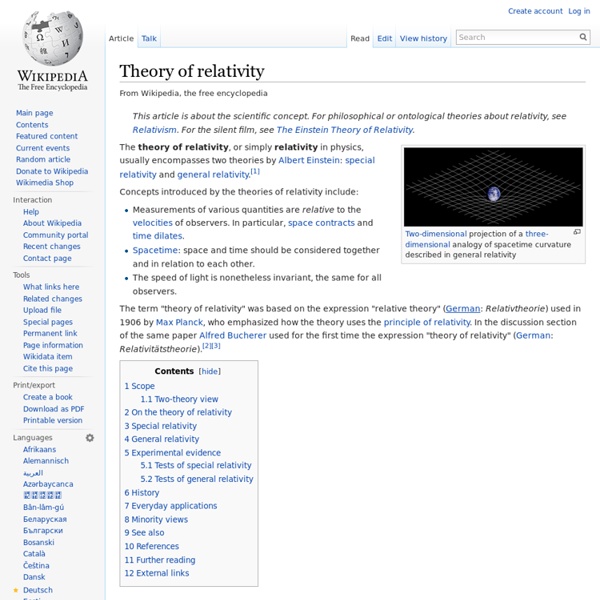Space Time Travel – Relativity Visualized
Thermodynamics
Annotated color version of the original 1824 Carnot heat engine showing the hot body (boiler), working body (system, steam), and cold body (water), the letters labeled according to the stopping points in Carnot cycle Thermodynamics applies to a wide variety of topics in science and engineering. Historically, thermodynamics developed out of a desire to increase the efficiency and power output of early steam engines, particularly through the work of French physicist Nicolas Léonard Sadi Carnot (1824) who believed that the efficiency of heat engines was the key that could help France win the Napoleonic Wars.[1] Irish-born British physicist Lord Kelvin was the first to formulate a concise definition of thermodynamics in 1854:[2] "Thermo-dynamics is the subject of the relation of heat to forces acting between contiguous parts of bodies, and the relation of heat to electrical agency." Introduction[edit] A thermodynamic system can be defined in terms of its states. History[edit] Etymology[edit]
Principle of relativity
In physics, the principle of relativity is the requirement that the equations describing the laws of physics have the same form in all admissible frames of reference. For example, in the framework of special relativity the Maxwell equations have the same form in all inertial frames of reference. In the framework of general relativity the Maxwell equations or the Einstein field equations have the same form in arbitrary frames of reference. Several principles of relativity have been successfully applied throughout science, whether implicitly (as in Newtonian mechanics) or explicitly (as in Albert Einstein's special relativity and general relativity). History of relativity[edit] Basic relativity principles[edit] Certain principles of relativity have been widely assumed in most scientific disciplines. Any principle of relativity prescribes a symmetry in natural law: that is, the laws must look the same to one observer as they do to another. Special principle of relativity[edit] See also[edit]
Save Today and Everyday - Affordable Solar Energy in Maryland
Classical mechanics
Diagram of orbital motion of a satellite around the earth, showing perpendicular velocity and acceleration (force) vectors. In physics, classical mechanics and quantum mechanics are the two major sub-fields of mechanics. Classical mechanics is concerned with the set of physical laws describing the motion of bodies under the action of a system of forces. The study of the motion of bodies is an ancient one, making classical mechanics one of the oldest and largest subjects in science, engineering and technology. It is also widely known as Newtonian mechanics. The term classical mechanics was coined in the early 20th century to describe the system of physics begun by Isaac Newton and many contemporary 17th century natural philosophers, building upon the earlier astronomical theories of Johannes Kepler, which in turn were based on the precise observations of Tycho Brahe and the studies of terrestrial projectile motion of Galileo. History[edit] Description of the theory[edit] Similarly,
What is Relativity?
Albert Einstein was famous for many things, but his greatest brainchild is the theory of relativity. It forever changed our understanding of space and time. What is relativity? The universality of physics means that history is provincial. It's all relative. Special relativity Einstein's theory is divided into special and general relativity. Special relativity came first and is based on the speed of light being constant for everyone. Einstein came to this conclusion in 1905 after experimental evidence showed that the speed of light didn't change as the Earth swung around the Sun. This result was surprising to physicists because the speed of most other things does depend on what direction the observer is moving. Einstein said that all observers will measure the speed of light to be 186,000 miles per second, no matter how fast and what direction they are moving. The answer is the headlights turn on normally, but only from the perspective of someone inside the spaceship. General relativity
Panneau solaire
Un article de Wikipédia, l'encyclopédie libre. Un panneau solaire est un dispositif technologique énergétique à base de capteur solaire thermique ou de capteur solaire photovoltaïque destiné à convertir le rayonnement solaire en énergie thermique ou en énergie électrique[N 1]. Présentation[modifier | modifier le code] Types[modifier | modifier le code] On distingue trois types de panneaux solaires : les panneaux solaires thermiques, appelés capteurs solaires thermiques, collecteurs solaires ou simplement capteurs solaires, qui piègent la chaleur du rayonnement solaire et la transfèrent à un fluide caloporteur ;les panneaux solaires photovoltaïques, appelés modules photovoltaïques ou simplement panneaux solaires, qui convertissent le rayonnement solaire en électricité. Dans les trois cas, les panneaux sont habituellement plats, d'une surface approchant plus ou moins le m² pour faciliter et optimiser la pose. Comparaison photovoltaïque-thermique[modifier | modifier le code] Soient et où
Statistical mechanics
Statistical mechanics is a branch of mathematical physics that studies, using probability theory, the average behaviour of a mechanical system where the state of the system is uncertain.[1][2][3][note 1] The present understanding of the universe indicates that its fundamental laws are mechanical in nature, and that all physical systems are therefore governed by mechanical laws at a microscopic level. These laws are precise equations of motion that map any given initial state to a corresponding future state at a later time. There is however a disconnection between these laws and everyday life experiences, as we do not find it necessary (nor easy) to know exactly at a microscopic level the simultaneous positions and velocities of each molecule while carrying out processes at the human scale (for example, when performing a chemical reaction). A common use of statistical mechanics is in explaining the thermodynamic behaviour of large systems. Principles: mechanics and ensembles[edit]



